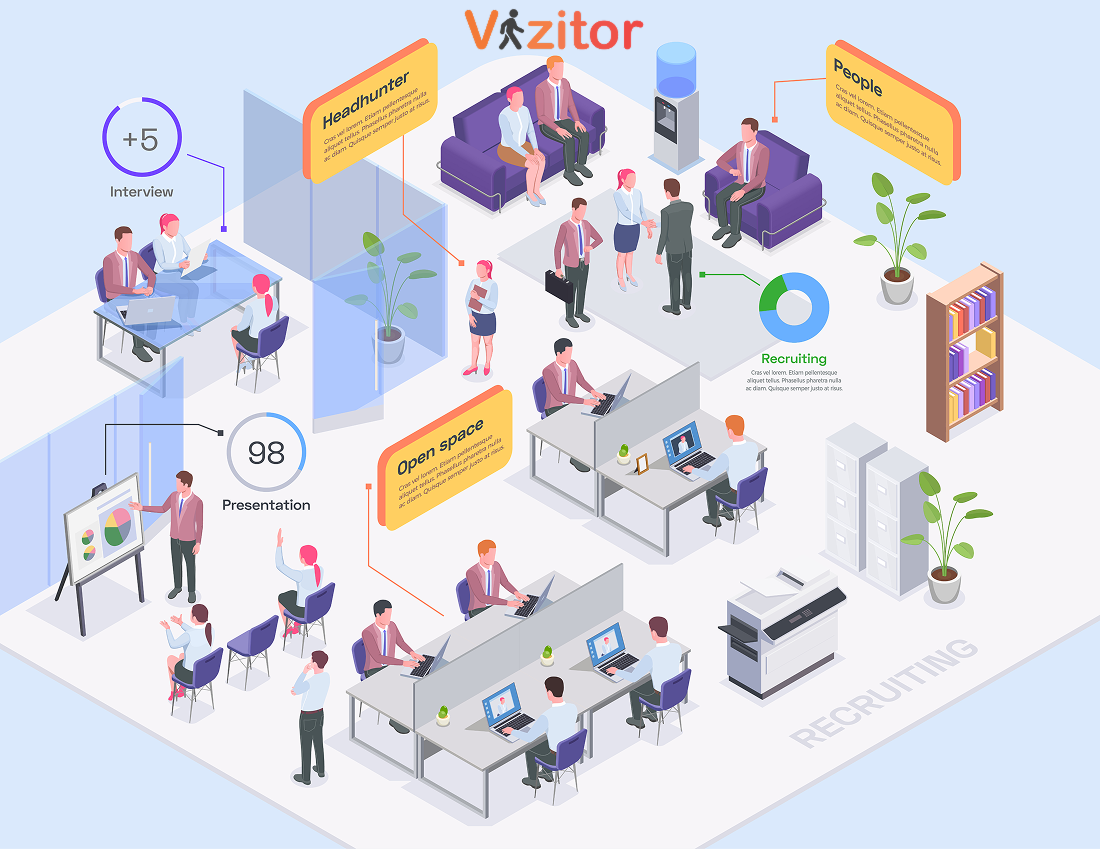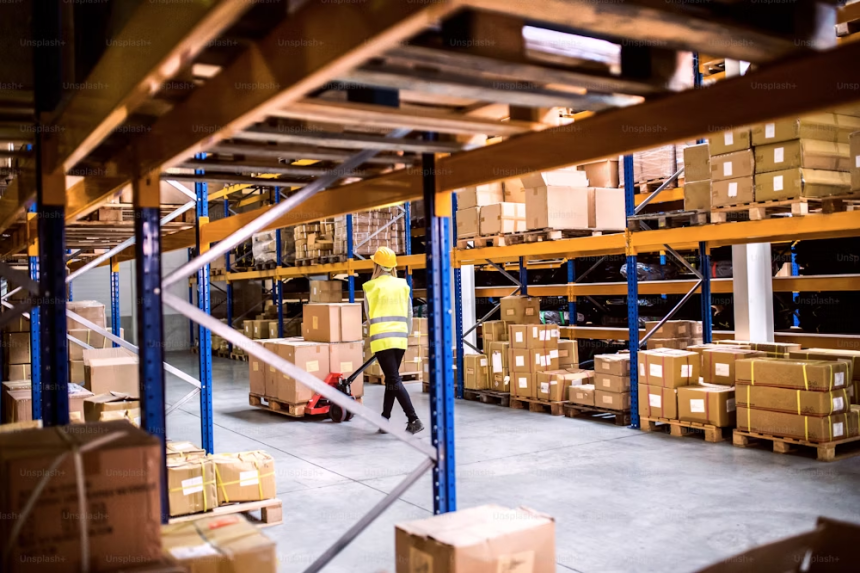Table of Content
Try Vizitor for Free!

Mon, Feb 24, 2025
Read in 10 minutes
The modern office has undergone a massive transformation. With hybrid work models becoming the norm in 2025, office spaces are no longer just physical locations where employees clock in and out.
Instead, they are digital environments designed to foster collaboration, enhance productivity, and maximize efficiency.
To create a workspace that aligns with business goals while supporting employees’ needs, strategic office space planning in 2025 is essential.
Strategic office space planning ensures that every square foot is optimized for maximum usability while accommodating both in-office and remote employees.
In this guide, we’ll explore the key aspects of office space planning and how businesses can design workspaces that foster innovation and efficiency.
Quick Summary
- A well-planned office improves productivity, collaboration, and cost savings.
- Hybrid offices need flexible layouts, shared workstations, and technology-integrated meeting rooms.
- Assessing space requirements helps determine the right balance between remote and in-office work.
What Is Office Space Planning and Why Is It Important?
Office space planning is the strategic organization of a workspace to ensure it meets employees’ needs while optimizing available space. It involves designing layouts, selecting furniture, and integrating technology to enhance productivity and collaboration.
According to a report by Colliers India, India’s commercial office space absorption reached 66.4 million square feet in 2024, marking a 14% year-on-year growth.
The demand is projected to reach 65-70 million square feet in 2025. Vacancy levels are expected to decline to 15-16% in 2025, with average rental values forecasted to reach ₹100-110 per square foot per month.
Also explore: The ultimate guide to Office Space Management
Key Benefits of Office Space Planning
Effective office space planning is more than just arranging desks and chairs—it’s about creating an environment that fosters productivity, collaboration, and employee well-being.
Here’s how a well-planned workspace benefits your business:
1. Maximized Productivity
A thoughtfully designed office layout helps employees work efficiently by reducing distractions and optimizing workflow.
- Defined Work Areas – Dedicated spaces for focused tasks minimize interruptions.
- Ergonomic Furniture – Reduces strain and enhances comfort for long work hours.
- Proximity to Essential Resources – Easy access to printers, meeting rooms, and supplies improves efficiency.
In 2024, India’s office space market experienced significant growth:
- Gross Absorption: Savills India reported a 21% year-on-year increase, totaling 75.2 million square feet.
- Net Absorption: JLL India recorded 49.56 million square feet, with Bengaluru leading at 14.74 million square feet.
2. Enhanced Collaboration & Communication
Modern workplaces dependson teamwork, and the right office design encourages spontaneous discussions, brainstorming sessions, and team synergy.
- Open Workstations – Foster easy communication between teams.
- Huddle Rooms & Breakout Spaces – Provide private spots for quick meetings.
- Flexible Seating Arrangements – Allow departments to interact without barriers.
3. Cost Savings & Space Optimization
Poor space utilization can lead to high real estate costs without delivering productivity benefits. Smart planning ensures every square foot is used effectively.
- Multi-Functional Spaces – Meeting rooms can double as workstations.
- Hot-Desking & Shared Workspaces – Reduce the need for excess desks and office space.
- Energy-Efficient Design – Optimized lighting, HVAC systems, and smart sensors reduce utility costs.
4. Supports Employee Well-Being
The modern office is more than a workplace—it’s an experience. Employee comfort influences job satisfaction, mental well-being, and retention rates.
- Natural Lighting & Green Spaces – Improve mood and energy levels.
- Ergonomic Furniture – Reduces strain and promotes better posture.
What are essential Elements of a Hybrid-Friendly Office in 2025?
The shift to hybrid work models has became a new standard. According to a 2025 Gartner report, 81% of companies now operate in a hybrid format, prioritizing flexibility and employee well-being.
Case study:
High-End Office Demand: Despite high vacancy rates, there’s a notable demand for premium office spaces. In London, rents for ultra-premium offices have surpassed £100 per square foot, with some leases reaching £122 per square foot.
A hybrid-friendly office must seamlessly integrate remote and in-office work, offering employees a productive, tech-enabled, and collaborative environment.
Here are the key elements that define a successful hybrid workplace in 2025:
1. Smart Office Technology & Seamless Connectivity
Technology is the backbone of hybrid work. A 2025 McKinsey study found that companies investing in smart workplace technology see a 35% boost in employee efficiency and a 40% reduction in IT-related downtime.
Offices need seamless connectivity between on-site and remote employees to ensure smooth operations.
- High-Speed Internet & 5G Integration – Essential for video conferencing, cloud computing, and digital collaboration.
- Cloud-Based Collaboration Tools – Platforms like Microsoft Teams, Slack, and Notion enable real-time teamwork.
- AI-Powered Meeting Rooms – Smart cameras, automated transcription, and voice recognition enhance virtual meetings.
2. Quiet Zones for Deep Work
Not every task requires collaboration, and a hybrid-friendly office should include dedicated quiet zones for employees who need to concentrate. Noise-canceling booths, acoustic panels, and smart lighting can help create an environment that minimizes distractions and boosts productivity.
3. Seamless Desk & Meeting Room Management
Managing office space efficiently is essential for hybrid workplaces. AI-driven desk reservation apps and occupancy sensors help optimize space utilization. Integrated scheduling tools prevent double bookings and ensure smooth coordination for in-person and remote teams.
4. Strong Digital Infrastructure
A hybrid-friendly office must have high-speed internet, secure cloud storage, and robust cybersecurity measures.
Employees should be able to access company resources securely from any location. Reliable IT support and regular software updates ensure smooth remote and in-office operations.
5. Cybersecurity & Data Protection for Hybrid Workforces
With employees working across multiple locations, data security is a top concern. A 2025 IBM Cybersecurity Report found that hybrid workplaces experience 42% more phishing attempts compared to traditional setups, making robust security measures critical.
- Zero Trust Security Framework – Requires authentication at every level to prevent breaches.
- AI-Driven Threat Detection – Predicts and neutralizes cyber threats in real-time.
- End-to-End Encryption & Secure VPNs – Protects remote access to company networks.
- Employee Cybersecurity Training – Ensures awareness of phishing scams and security protocols.
6. Efficient Storage Solutions
With hybrid employees switching between home and office work, personal storage lockers or dedicated storage spaces help reduce clutter and improve organization.
By incorporating these elements, organizations can create a hybrid workspace that enhances productivity, collaboration, and employee satisfaction while adapting to the evolving work environment in 2025.
How to Plan an Efficient Office Space in 2025
Creating an optimized office space requires strategic planning to ensure functionality, comfort, and productivity. Below is a detailed step-by-step guide to designing an efficient workspace that aligns with modern work trends.
1. Analyze Your Space and Requirements
Before making any structural or design changes, conduct a thorough analysis of your office’s current setup and future needs. Consider the following key factors:
a) Employee Headcount and Work Patterns
- How many employees will use the office daily?
- Is your workforce full-time office-based, hybrid, or fully remote?
- Will you have a flexible workforce that changes in size over time?
Understanding these numbers will help determine how much space you actually need, avoiding both overcrowding and underutilization
b) Workstation Preferences
- Do employees need dedicated desks, or will hot-desking work better?
- Will shared workstations encourage better space utilization?
- Should you include private booths for focused tasks?
Different job roles require different types of workspaces.
For example, a developer may need a quiet, dedicated desk, while a marketing team may prefer an open, collaborative environment.
c) Collaboration and Meeting Room Needs
- Are there enough meeting rooms to accommodate teams?
- Do teams prefer formal conference rooms or casual breakout spaces?
- Are hybrid meetings common, requiring advanced video conferencing tools?
Having the right mix of private, semi-private, and open collaboration spaces ensures smooth teamwork without disturbing individual work.
2. Choose the Right Office Layout
Once you have assessed your space requirements, selecting an office layout that fits your company’s workflow is crucial. Some of the most effective layouts include:
a) Open-Plan Layout
- Ideal for companies that prioritize collaboration and teamwork.
- Eliminates physical barriers between employees, promoting communication.
- Works best when complemented with quiet zones to balance noise levels.
Best for: Startups, creative agencies, sales teams.
b) Zoned Layout
- Separates different work functions into distinct zones.
- Common zones include collaboration areas, focus zones, and lounge spaces.
- Ensures a structured office flow while offering flexibility.
Best for: Mid-to-large organizations, hybrid teams.
c) Hybrid Layout
A combination of open workspaces, dedicated desks, and shared spaces.It supports both individual work and group collaboration.It works well for companies with hybrid work policies.
Selecting the right layout ensures that employees can work efficiently, whether they need to concentrate, collaborate, or relax.
3. Invest in Smart Office Technology
A modern office isn’t just about furniture and layout—it must also be tech-enabled for seamless operations. Here’s what to prioritize:
A modern office should be equipped with smart technology to enhance efficiency and connectivity.
High-speed internet with reliable Wi-Fi coverage ensures smooth operations, while digital meeting room systems with smart booking, AI-powered noise cancellation, and interactive whiteboards improve collaboration.
Investing in these technologies creates a seamless and productive work environment.
4. Optimize and Adapt Over Time
To maintain an efficient office space over time, it’s essential to continuously assess and adapt to changing needs.
Gathering employee feedback helps identify issues like noise levels, meeting room availability, and workspace comfort. Monitoring space utilization data allows for optimizing layouts based on real-time trends.
Staying updated with workplace innovations and sustainable solutions ensures the office remains functional, cost-effective, and aligned with evolving workforce expectations. Regular improvements keep the workspace efficient, productive, and conducive to employee well-being.
5. Using Space Management Tools and Softwares
Office resource booking software helps streamline space management by allowing employees to reserve desks and meeting rooms in advance, preventing overcrowding and ensuring efficient workspace utilization.
Smart solutions like digital booking systems and data-driven space utilization ensure seamless operations. Using a reliable space management system like Vizitor helps businesses optimize their office setup, manage workstations efficiently, and create a productive environment tailored to evolving workforce trends.
Also explore: What is Space Management Software
Vizitor’s Space Management System – Smart Office Space Planning in 2025
Vizitor’s Space Management System helps businesses efficiently utilize office space, ensuring seamless collaboration and optimized resource allocation.
What are Key Features of Vizitor’s Space Management Software? :
Hot-Desking & Desk Booking – Allow employees to reserve desks as per their needs.
Meeting Room Management – Hassle-free scheduling to avoid conflicts and maximize usage.
Real-Time Space Analytics – Get insights into space utilization and optimize resources.
Automated Access Control – Secure check-ins for employees, visitors, and contractors.
Hybrid Workspace Support – Perfect for flexible work environments.
Final Thoughts
Office space planning in 2025 is about balancing flexibility, collaboration, and efficiency while keeping employee well-being in mind. Whether designing a brand-new office or optimizing an existing one, businesses must focus on hybrid work needs, smart technology, and sustainable practices.
By thoughtfully planning your office layout, investing in modern workplace solutions, and continuously adapting to employee preferences, you can create an office space that supports productivity, reduces costs, and enhances overall job satisfaction.
With Vizitor, transform your office into a smart, efficient, and cost-effective workspace!
Contact us today for demo!
Frequently Asked Questions (FAQ)
- What is office space planning, and why is it important?
Office space planning is a strategic process that involves designing the layout, furniture, and technology in a way that maximizes productivity and collaboration.
A well-planned office space enhances workflow efficiency, reduces clutter, and ensures better utilization of available space.
- What type of furniture is essential for a hybrid office?
A hybrid office requires ergonomic desks and chairs, collaborative meeting tables, soundproof booths, lockers, and flexible furniture for hot-desking. Tech-integrated seating and adjustable workstations improve comfort and productivity.
- How can you design an effective office layout?
An effective office layout should prioritize workflow efficiency, employee comfort, and space optimization. It should include designated zones for collaboration, focus work, and relaxation, ensuring a balance between open and private spaces.
- How does a space management system improve office efficiency?
A space management system helps organizations track workspace usage, optimize desk allocation, and streamline meeting room bookings. It improves space utilization, reduces operational costs, and enhances employee experience by providing real-time availability and scheduling solutions.
- How can Vizitor Space Management System improve workplace efficiency?
Vizitor Space Management System streamlines space allocation by allowing employees to book desks, meeting rooms, and common areas in advance. It eliminates conflicts, ensures better space utilization, and provides analytics to improve workplace planning.
- Can Vizitor help in tracking space occupancy?
Yes, Vizitor provides real-time insights into workspace occupancy, helping organizations monitor which areas are underutilized or overcrowded. This data aids in optimizing office layouts and reducing unnecessary costs.







